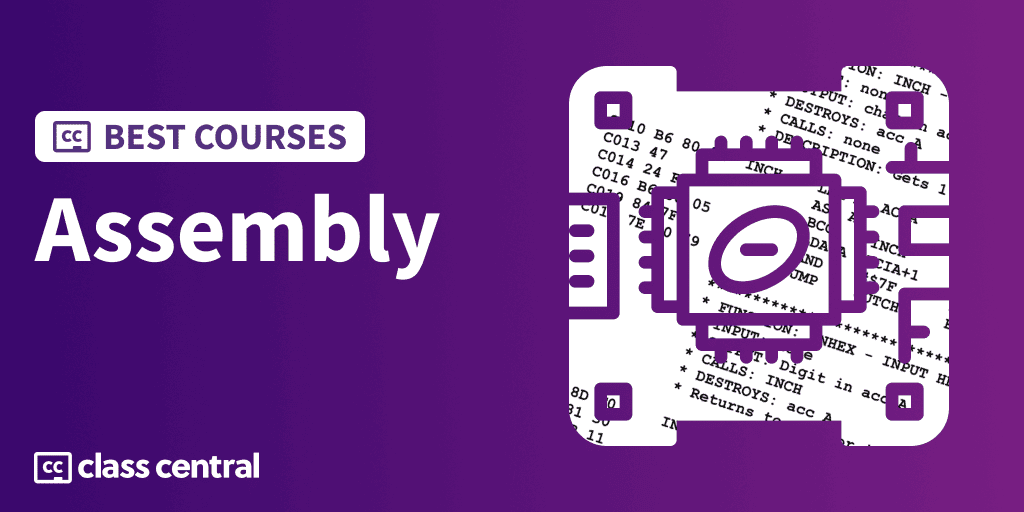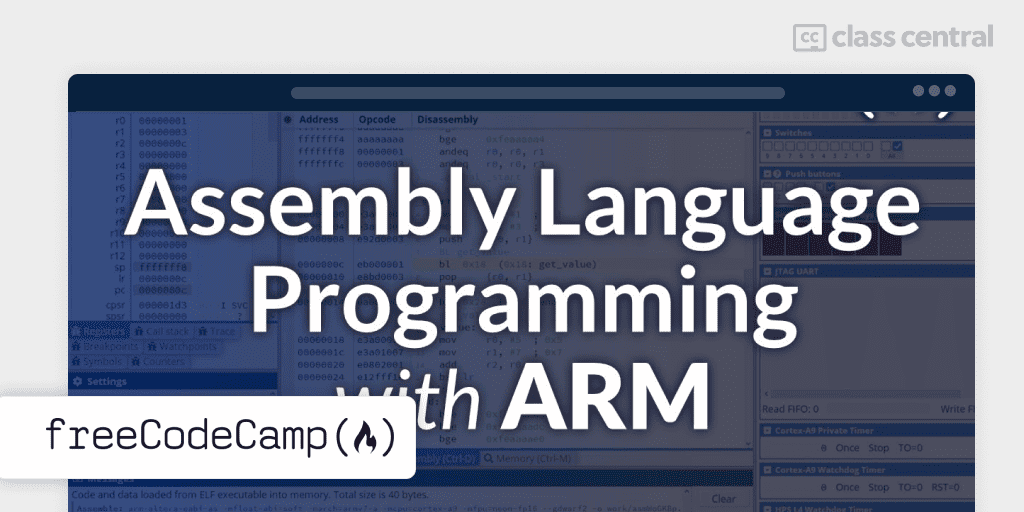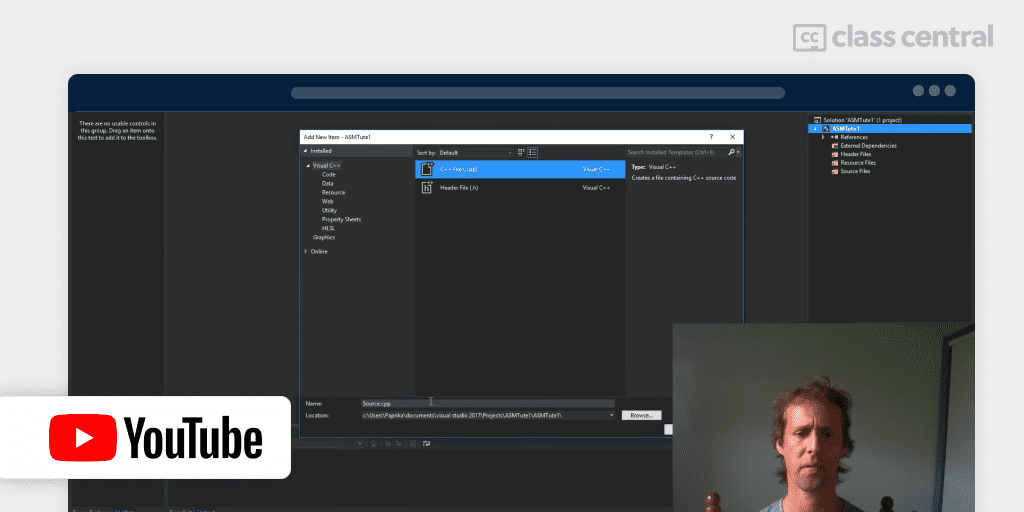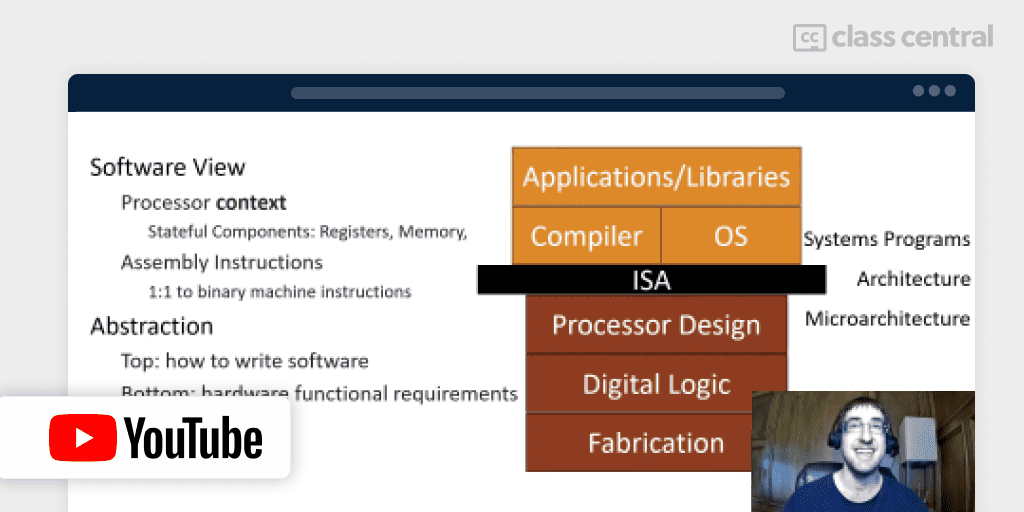Bare-Metal Programming: 10 Best Assembly Language Courses for 2024
Looking to decode the mysteries of low-level programming? Then, you’ve landed in the right place!

Whether you’re a curious hobbyist eager to understand your computer’s inner workings, a seasoned programmer aiming to optimize your code, or an aspiring cybersecurity expert looking to reverse engineer malicious software, we have the courses just for you.
Before diving in, it’s important to note that most of the courses in this list recommend prior programming experience with C. If you’re new to C programming, I recommend you take a look at my guide on the best C programming courses.
In this article, I’ve handpicked the 10 best Assembly language courses you can take in 2023, each offering a unique pathway into the world of low-level programming. Get ready to turn the dial of your coding prowess up to eleven!
There are many different types of assembly languages, so I’ve organized these courses into the following categories below if you are interested in a specific language:
Here are my top picks. Click on one to skip to the course details:
| Course highlight |
Workload |
| Best ARM Assembly Course for Beginners (freeCodeCamp) | 2–3 hours |
| Develop Games in Arm Assembly for Gameboy and Nintendo DS (Akuyou) | 5 hours |
| Understand ARM Assembly for Exploit Development (Azeria Labs) | N/A |
| Architecture and x86-64 Assembly for Professionals (OpenSecurityTraining2) | N/A |
| Learn Modern x64 Assembly (Creel) | 4–5 hours |
| Best RISC-V Assembly Course for Beginners (The Linux Foundation) | 10–15 hours |
| Assembly Programming With RISC-V (Gedare Bloom) | 1 hour |
| Learn x86 and ARM Assembly in One Course (Cybrary) | 13–14 hours |
| Master Assembler Language for Mainframes (Doane University) | 55–110 hours |
| Solve Assembly Code Puzzles in TIS-100 (Steam) | N/A |
What is Assembly?
Assembly language is, in essence, a human-readable version of machine code, enabling programmers to write code that can be understood more easily than raw binary instructions. Let me illustrate what that means with an example.
Here’s an instruction written in binary for a x86/IA-32 processor:
10110000 01100001
It looks like an indecipherable string of ones and zeroes, doesn’t it? How could anyone understand it? Well, this is machine code and you aren’t meant to be able to understand it, as this language is written for computers. Yes, all your JavaScript and Python and C and Go are all reduced to a complex string of binary numbers by the time it reaches the CPU.
But if one wants to communicate in the most elemental language for computers, it’ll be tough to write in such an unfamiliar way. Thus, to bridge the gap between machine code and human understanding, computer scientists developed assembly language, in a more human-friendly form. If I tell you that the instruction before actually means:
MOV AL, 97
You can easily find out what this means just by having a reference sheet on hand and some knowledge of binary. Vice-versa, you don’t have to write 1s and 0s to program a computer. Instead, you can write in assembly language and then use an assembler to translate your code into machine code. And that’s the essence of assembly language!
Now, even if assembly is way easier than machine code, that doesn’t mean that it’s easy. You rarely find people programming in assembly language these days. So why learn assembly?
- You are a reverse engineer working in cybersecurity, dissecting malware to understand its functions or understanding legacy code in old software.
- You want to super-optimize your code, perhaps for a game or for high-performance computing.
- You have to work at a very low level, often interacting directly with the hardware. For example, you deal with embedded systems and write firmware.
There are many different kinds of assembly language, and the three most popular are as follows:
- ARM: Widely used in mobile devices like smartphones and tablets, but can also be found in laptops and servers. Its RISC design philosophy makes it super power-efficient.
- x86-64: Primarily used in desktop, laptop computers, servers and high-performance computing systems. Follows the CISC design philosophy and is best for complex workloads.
- RISC-V: Emerging use in a variety of fields, including microcontrollers, embedded systems, and even supercomputers. Unlike ARM and x86, RISC-V is open-sourced.
ARM
Best ARM Assembly Course for Beginners (freeCodeCamp)

Have you programmed in a high-level language before, but have no idea how to approach low-level programming? Scott Cosentino’s free video course is the best ARM course for you, specifically ARMv7 architecture used primarily in mobile devices or single-board computers like the Raspberry Pi 2.
This course begins with the basics of ARM architecture and swiftly moves into the intricacies of working with registers (general-purpose vs special-purpose) and instructions (made up of opcodes, operands, and addressing modes). You’ll first learn how to manipulate and move data around with arithmetical operations, logical shifts, and rotations, before composing these instructions together to create more complex higher-level constructs such as conditional statements, branching, and looping constructs. Not only that, you’ll also be able to save and access data from stack memory with pops and pushes.
One of the main reasons why programmers use assembly languages is to exert finer control over the machine’s hardware, such as their I/O devices. Thus, you’ll learn how to interact with devices such as switches and LEDs.
For the final part of the course, you’ll switch over to Linux-based systems instead of an emulator. Here, you’ll explore how to interact with the OS using system calls and system interrupts, and in fact write a mandatory “Hello World!” program. Of course, the more lines of code you write, the higher the chance of introducing bugs in your program. You’ll find that the best friend of an assembly-level programmer is a debugger such as the GDB (GNU Debugger) with all sorts of nifty functions to help ease the pain of debugging, like stepping through instructions, viewing register values, and examining parts of memory.
To take this course, you’ll need some experience with programming, and while the last part of the course requires a Linux-based machine, most of the course is done on an online emulator, meaning that you’ll come out with a strong understanding of ARM architecture and assembly languages anyway.
| Institution | freeCodeCamp |
| Provider | YouTube |
| Instructor | Scott Cosentino |
| Level | Beginner |
| Workload | 2–3 hours |
| Views | 920K |
| Likes | 15K |
| Certificate | None |
Develop Games in Arm Assembly for Gameboy and Nintendo DS (ChibiAkumas)

Pssstt… wonder how nostalgic pixel art classics like Pokémon Ruby were developed on hand-held gaming consoles back in the 2000s?
Akuyou is a programmer and game developer of the 8-bit bullet-hell action ChibiAkumas series of games, and by the end of his free video course (with a matching text lesson), you’ll be able to write programs on RiscOS, and even start making your own 8-bit graphical games in ARM assembly on the Game Boy Advance and Nintendo DS — no programming experience required! You’ll use the assembler tool VASM in this course.
The first thing you need to understand before jumping into the ARM architecture is the binary and hexadecimal number systems, which computers work better with than the decimal number system. In fact, you’ll see heavy use of them in registers, which store data as numeric values. You’ll learn the many types of registers and their uses in a typical ARM system.
Next, you’ll learn how to interact with these registers by writing assembly line commands in a .asm file, consisting of three parts: header, program, and footer. With these simple commands, you can perform arithmetic and logical operations. Then, you’ll discover the different kinds of addressing modes that affect the way you interact with memory.
But doing mathematics and moving data in and out of memory isn’t enough to make a truly interesting program. You’ll learn how to add branches — constructs that allow the program to ‘decide’ what actions to take if a specific condition is fulfilled. These branches also allow you to make loops to repeat the same instructions over and over again.
We’ve learned how to save values in memory, but what about if we want to store a value for a very short time, for example the HP of a character? This is where stack comes in! You’ll learn the operations needed to manipulate a stack, and also learn how stacks are used system calls, i.e using pre-built functions defined in the OS. Finally, the course ends with an overview of a few other important arithmetic and logical operations.
Once you’re done with this course, you can move on to this course on making 16-bit color games on the Gameboy Advance and Nintendo DS.
| Provider | YouTube |
| Instructor | Keith ‘Akuyou’ Sear |
| Level | Beginner |
| Workload | 5 hours |
| Certificate | None |
Understand ARM Assembly for Exploit Development (Azeria Labs)

Whereas the other ARM courses are mostly about developing programs, this free text-based course by Azeria Labs is about ARM exploit development. You’ll learn how to write ARM 32-bit assembly code on the ARMv6 architecture, and by the end, you’ll be able to write shellcode and debug programs with GDB.
To follow along with the examples provided, you’ll need an ARM-based lab environment on either a physical device or a virtual machine.
First, you’ll learn what ARM is and how its architecture and instruction set differs from ARM Intel processors. Then, you’ll learn about the different data types and operations that ARM supports, including the purpose of the different registers. Afterward, you’ll study the ARM instruction set in detail, dividing them into three categories: Data Processing Instructions, Multiply and Multiply-Accumulate (MAC) Instructions, and Branch Instructions. These instructions allow you to perform arithmetic operations, logical operations, multiplication operations, and control the flow of execution based on conditions.
Loading and storing data is an essential part of ARM assembly coding, as you’ll have to do it yourself. There are three basic offset forms with three different address modes for each form, which you’ll learn, not to mention that you can also store load / store multiple values at once. Conditional execution and branching will also be covered in the course, and lastly you’ll wrap up the course by looking at a special memory region of the process called the Stack and understand how it is used in ARM not only to store data but to also call functions.
| Institution | Azeria Labs |
| Level | Beginner |
| Workload | N/A |
| Certificate | None |
x84-64
Best Architecture and x86-64 Assembly Course for Professionals (OpenSecurityTraining2)

Q: What do the following have in common? Reverse Engineer, Malware Analyst, System Security Researcher.
A: They all require an understanding of Assembly code!
OpenSecurityTraining2’s free course, taught by its founder, Xeno Kovah, is an excellent course for those interested in the inner workings of hardware and software. In fact, this course serves as an introduction to a more advanced course, x86-64 OS Internals.
In this course, you’ll learn the most commonly generated assembly instructions and most frequently dealt with architecture hardware. By the end of this course, you’ll be able to read most programs just by knowing 20-30 instructions and variations. By emphasizing the importance of practice (going through the many, many code examples) and sneaking in references to pop culture, you’ll find this course a breeze and not a bore!
Do note that you should be comfortable with C programming before taking this course.
| Provider | OpenSecurityTraining2 |
| Instructor | Xeno Kovah |
| Level | Beginner |
| Workload | N/A |
| Certificate | None |
Learn Modern x64 Assembly (Creel)

Another great free x64 Assembly course for beginners is Creel’s YouTube playlist, Modern x64 Assembly.
This comprehensive introduction provides all you need to know about modern x64 assembly language programming, from the basics of the language and its operations, to more advanced topics such as bit manipulation, control structures, and SIMD processing (very important!). Not only that, you’ll also understand deeply how code interacts with hardware underneath the hood. Finally, you explore and compare the big differences in implementation between written C++ and assembly code.
| Channel | Creel |
| Provider | YouTube |
| Instructor | Chris |
| Level | Beginner |
| Workload | 4–5 hours |
| Views | 240K |
| Likes | 5.6K |
| Certificate | None |
RISC-V
Best RISC-V Assembly Course for Beginners (The Linux Foundation)

The Linux Foundation’s RISC-V course is a good choice for software developers working with a RISC-V microprocessor. Taught by Matthias Koenig, you’ll find out what instructions are actually executed by the processor when it runs a C program, which includes: unprivileged instructions set architecture, pseudo instructions, the application binary interface for system calls, and library calls by examples.
That’s not all you’ll learn though; the course aims for you to be comfortable writing and reading RISC-V assembly. That means you’ll know what tools are available to developers, such as the toolchain required to translate source code into an executable, and debuggers that help you, well, debug code.
You don’t need to know any other assembly language to take this course, only basic programming knowledge. All of the course materials, which are mostly text-based, are free-to-audit. However, the quizzes and final exam are only available for verified learners. Also, the instructors are active on the course’s discussion forum, so make the best use of them!
| Institution | The Linux Foundation |
| Provider | edX |
| Instructor | Matthias Koenig |
| Level | Intermediate |
| Workload | 10–15 hours |
| Certificate | Paid |
Assembly Programming With RISC-V (Gedare Bloom)

If you prefer a more concise course that condenses all you need to know to start programming in RISC-V, Gedare Bloom’s course is just for you. Unlike the previous pick, this course is a video course filled with diagrams and visualizations, so visual learners will love this.
Here’s what you’ll learn in each video:
- Video 1: RISC-V registers and load/store word instructions.
- Video 2: Basic RISC-V arithmetic/logic instructions.
- Video 3: RISC-V control flow instructions and converting loop structures for easier assembly generation.
- Video 4: Making procedure/function calls with RISC-V, including a brief discussion on recursive functions (excluding recursion explanation).
| Channel | Gedare Bloom |
| Provider | YouTube |
| Instructor | Gedare Bloom |
| Level | Beginner |
| Workload | 1 hour |
| Views | 30K |
| Likes | 395 |
| Certificate | None |
Other / Educational
Learn x86 and ARM Assembly in One Course (Cybrary)

Are you a dedicated learner who would rather learn both x86 and ARM assembly in one course?
In this comprehensive paid Cybrary course, part of the SOC Analyst career path, you’ll not only learn how to read and write assembly code, but you’ll also pick up useful skills you can do with assembly too. For example, reverse engineering malicious software by reading their binary files and understanding how the GCC compiles high level concepts such as data structures and functions into low level assembly. And don’t worry if your knowledge of data structures is rusty — the course brushes up on that, specifically the stack.
Thus, by the end of this course, you’ll be able to compare and contrast x86 and ARM assembly code and architecture, Oh, and not to mention that you’ll also get a certificate of completion.
Note that you should have a background in basic programming concepts prior to taking this course.
| Provider | Cybrary |
| Instructor | Matthew Miller |
| Level | Beginner |
| Workload | 13–14 hours |
| Bookmarks | 534 |
| Rating | 3.86 / 5 (14) |
| Certificate | Paid |
Master Assembler Language for Mainframes (Doane University)

The succinctly named free-to-audit Assembler Language university-level course distinguishes itself from other courses in this list.
What makes this course stand out from the others is that it neither teaches x86 or ARM assembly. Instead, you’ll be writing assembly code for an IBM mainframe computer, which is quite different. All of your programs will be executed on a z390 mainframe assembler emulator which you can download for free on Windows.
The instructors at Doane University have certainly made the course impressively thorough. You’ll start from ground zero, digital logic and data representation, and work your way up with computer organization and so on until you’ve mastered the art of writing high-level and machine-level algorithms. The course is chock-full of examples, demonstrations, and explanations. A plethora of exercises and quizzes are included as well, but only if you’re a verified learner will you be able to access them.
Do note that knowledge and experience with a modern high-level programming language (e.g: Python, C++) is required to take this course.
| Institution | Doane University |
| Provider | edX |
| Instructor | Alec Engebretson and Mark Meysenburg |
| Level | Intermediate |
| Workload | 55–110 hours |
| Certificate | Paid |
Solve Assembly Code Puzzles in TIS-100 (Steam)

All of the courses here are mostly for experienced programmers, but here’s a fun pick that’s doable even for non-programmers — all you need is guts!
TIS-100 is not actually a course, but a 2015 paid indie game developed by Zachtronics. Set in a retro-styled virtual computer, TIS-100 takes you on a journey that will test your problem-solving skills and logic in a unique way. You’re given a series of programming puzzles where you must manipulate and optimize assembly code to achieve specific goals. Each puzzle presents you with a broken program that you must fix and improve to meet the required specifications. You’ll find this game to be enjoyable, that is if you’re willing to embrace the challenge.
| Studio | Zachtronics |
| Developer | Zach Barth |
| Level | Beginner |
| Rating | Overwhelmingly Positive (2,945 reviews) |
| Workload | N/A |
| Certificate | N/A |
Best Courses Guides Methodology
I built this ranking following the now tried-and-tested methodology used in previous Best Courses Guides (you can find them all here). It involves a three-step process:
- Research: I started by leveraging Class Central’s database with 150K online courses and 200K+ reviews. Then, I made a preliminary selection of 20+ Assembly courses by rating, reviews, and bookmarks.
- Evaluate: I read through reviews on Class Central, Reddit, and course providers to understand what other learners thought about each course and combined it with my own experience as a learner.
- Select: Well-made courses were picked if they presented valuable and engaging content and they have to fit in a set of criteria and be ranked accordingly: comprehensive curriculum, affordability, release date, ratings and enrollments.






